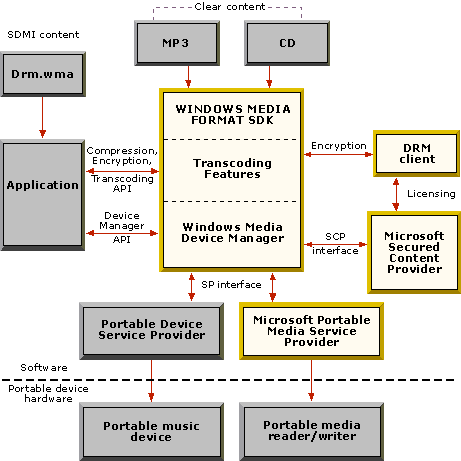
 |
| Previous | Next |
The following diagram shows how the components of Windows Media Device Manager (white boxes) work with application software to download music, in an SDMI-compliant manner, to a portable music player or to portable media. The discussion that follows explains this process as it is shown in the diagram.

If the content to be downloaded is already protected by SDMI methods, the application can pass the content directly to Windows Media Device Manager through the application programming interface (API).
Clear (unprotected) content, such as MP3 or compact disc (CD) music, should not be passed to Windows Media Device Manager in a clear form unless the target device is a non-SDMI device. For SDMI-compliant devices, the application must protect (encrypt) and/or validate any clear content using the Microsoft® Windows Media™ Format Software Development Kit (SDK), which in turn calls on the digital rights management (DRM) client to do encryption.
After the application has validated or protected the content, the application passes it on to Windows Media Device Manager. To check the rights and licensing of the content, Windows Media Device Manager communicates with the Secure Content Provider (SCP) through the SCP interface (SCPI). The SCP uses the services of the DRM client for licensing.
When rights and licensing have been ascertained, Windows Media Device Manager provides a license, if needed, for the portable device or medium. Then, using the Service Provider interface (SPI), it passes the license and secured content to the Portable Media Service Provider, or to a portable device service provider developed by a third party. The service provider module controls the portable player device or media reader/writer to record the content in an SDMI-compliant manner.
The Windows Media Device Manager Programming Guide and Programming Reference explain and document the application programming interface (API), the Service Provider interface (SPI), and the Secure Content Provider interface (SCPI).
| Previous | Next |